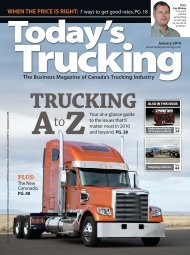Create successful ePaper yourself
Turn your PDF publications into a flip-book with our unique Google optimized e-Paper software.
So Where Are We?<br />
Truck sales are jumping, but does that really signify<br />
a healthy industry?<br />
Cyclical. It’s a word commonly used to describe our industry.<br />
And as descriptors go, it’s about as accurate as you’ll<br />
get. We know valleys. We know peaks.<br />
Truck makers understand these ups and downs only too well,<br />
and right about now there’s much buzz amongst them and major<br />
component suppliers as to how many trucks will be sold this year.<br />
The bigger mystery, of course, is 2007, when another round of<br />
emissions standards kicks in that will raise the price of a truck by<br />
quite a few thousand bucks. Volvo has just pegged it at US$7,500,<br />
calling it a “surcharge.” Others have gone higher than that.<br />
No matter the source, estimates for class-8 truck sales for ’06<br />
are all above 300,000 units for Canada, the United States, and<br />
Mexico combined. People are smiling, records are being set. The<br />
grin soon changes to a look of mild confusion at best when they<br />
consider next year, however. Estimates seem to be all over the<br />
map, but in the context of recent history, it doesn’t look like a<br />
horrible year at all. I can remember a time when we dropped<br />
below 100,000, but we may not even fall much below 200,000 in<br />
2007. The Cummins number, for example, is about 190,000,<br />
according to Jim Kelly, president of the company’s engine<br />
business. He says it’s likely to be “…a moderately decent year.”<br />
There was a time when increases in demand like we’ve seen in<br />
the last year or so would have led truck makers to expand, at least<br />
by adding a shift or two if not by adding bricks and mortar.<br />
Nobody’s done that this time out. Lessons were learned, so this<br />
peak and next year’s valley are being managed pretty well, it<br />
seems to me.<br />
That said, this particular stretch in the industry’s longer-term<br />
cycling is entirely artificial. It doesn’t reflect economic activity of<br />
a sort that puts more freight—or less—on a trailer. It reflects no<br />
more than the impact of environmental legislation as carriers buy<br />
trucks in advance of the ’07 price hike. Which means, in turn,<br />
that we’re getting no clues about the longer term from what’s<br />
happening today.<br />
Predicting is a mug’s game nowadays anyhow, no matter the<br />
industry. Wars and terrorism and natural catastrophes and who<br />
knows what else can wreak havoc and change tomorrow in an<br />
instant. I can’t find anybody, honestly, who’s brave enough to paint<br />
a 10-year picture for me on the record. Nor a five-year picture. Hell,<br />
going beyond the first half of next year is too big a challenge.<br />
Still, this being our annual Top 100 issue, I feel the urge to<br />
By Rolf Lockwood<br />
Editorial<br />
assess things and look at least a little ahead. As you’ll read elsewhere<br />
in these pages, the for-hire picture has changed. The fleets<br />
hovering around the number 100 mark are smaller than they used<br />
to be, reflecting consolidations at the top of the heap.<br />
Does it mean fewer fleets in fact? No, apparently not. The latest<br />
Statistics Canada report covering the third quarter of last year<br />
says we had some 3,376 for-hire outfits with annual revenues of<br />
$1 million or more, which was—surprisingly, I think—an 8.4-percent<br />
rise from 3Q 2004. The<br />
good news in there is that revenues<br />
for the quarter were up<br />
by 9.5 percent while expenses<br />
rose by only 7.6 percent.<br />
So the question is, can we<br />
sustain it? And do such fig-<br />
I can’t find anybody,<br />
honestly, who’s brave<br />
enough to paint a<br />
10-year picture for me<br />
on the record. Nor a<br />
five-year picture.<br />
ures really represent what’s<br />
happening?<br />
On the first question…<br />
beats me, I have to say. It<br />
seems clear that problems on<br />
the automotive front, amongst<br />
the so-called Big Three at least,<br />
point to difficulty in the short<br />
term. That’s especially true for<br />
carriers in central Canada, of course. Rather severe challenges in<br />
the pulp-and-paper world appear likely to be more lasting, maybe<br />
permanent, and downright devastating for some carriers in<br />
Quebec and Atlantic Canada. Try getting an outbound load from<br />
New Brunswick these days.<br />
And, by extension, try paying for an ’07 engine.<br />
So if industry-wide numbers improve, to a large extent it will<br />
be on the increasingly broad shoulders of western truckers who<br />
work around the oil patch, though not necessarily directly<br />
involved in it. As you’ll read elsewhere in this issue, ‘gangbusters’<br />
is the word to apply there. With no valley in sight,<br />
they’re enjoying life at the top of the cycle.<br />
And with an Albertan Prime Minister to boot. Can’t get<br />
much better. ▲<br />
Rolf Lockwood is editorial director and publisher of Today’s <strong>Trucking</strong>.<br />
You can reach him at 416-614-5825 or rolf@todaystrucking.com.<br />
MARCH 2006 9



